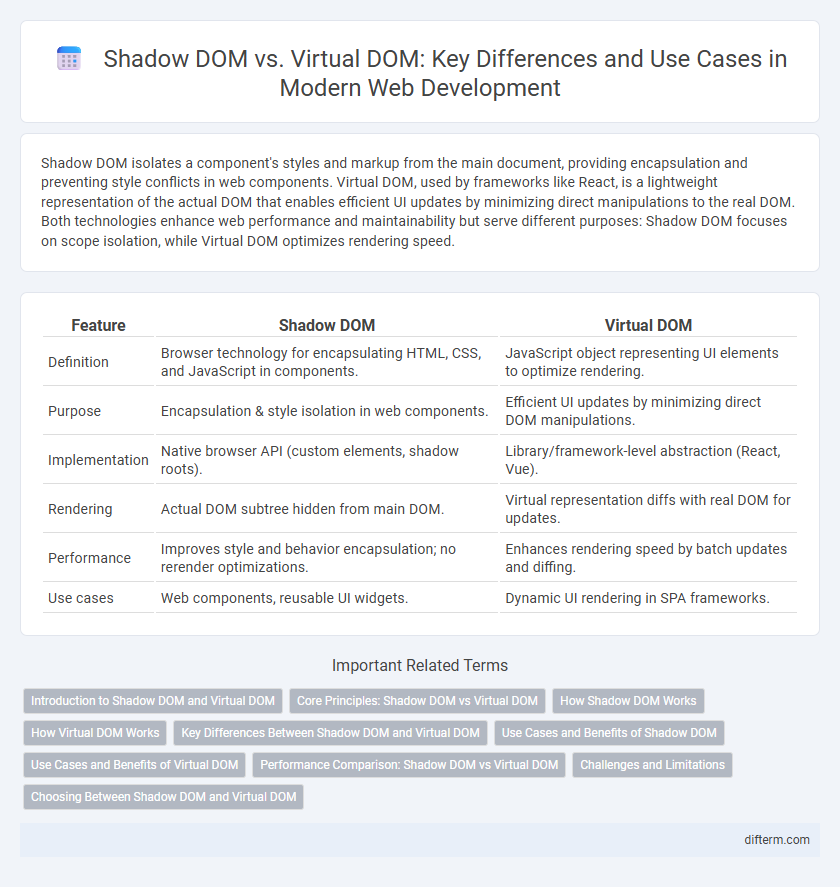Shadow DOM isolates a component's styles and markup from the main document, providing encapsulation and preventing style conflicts in web components. Virtual DOM, used by frameworks like React, is a lightweight representation of the actual DOM that enables efficient UI updates by minimizing direct manipulations to the real DOM. Both technologies enhance web performance and maintainability but serve different purposes: Shadow DOM focuses on scope isolation, while Virtual DOM optimizes rendering speed.
Table of Comparison
| Feature | Shadow DOM | Virtual DOM |
|---|---|---|
| Definition | Browser technology for encapsulating HTML, CSS, and JavaScript in components. | JavaScript object representing UI elements to optimize rendering. |
| Purpose | Encapsulation & style isolation in web components. | Efficient UI updates by minimizing direct DOM manipulations. |
| Implementation | Native browser API (custom elements, shadow roots). | Library/framework-level abstraction (React, Vue). |
| Rendering | Actual DOM subtree hidden from main DOM. | Virtual representation diffs with real DOM for updates. |
| Performance | Improves style and behavior encapsulation; no rerender optimizations. | Enhances rendering speed by batch updates and diffing. |
| Use cases | Web components, reusable UI widgets. | Dynamic UI rendering in SPA frameworks. |
Introduction to Shadow DOM and Virtual DOM
Shadow DOM encapsulates a section of the DOM tree, creating isolated components with their own scope for styles and scripts, enhancing modularity in web development. Virtual DOM is a lightweight, in-memory representation of the actual DOM used by frameworks like React to efficiently update UI by minimizing direct DOM manipulations. Both technologies optimize rendering and improve performance but serve distinct purposes: Shadow DOM for component isolation and Virtual DOM for smart UI updates.
Core Principles: Shadow DOM vs Virtual DOM
Shadow DOM encapsulates component styles and markup by creating a separate, isolated DOM tree within a web component, enhancing style scoping and preventing CSS conflicts. Virtual DOM, on the other hand, is a lightweight JavaScript representation of the actual DOM used to optimize rendering by diffing and batching updates before applying changes to the real DOM. The core principle of Shadow DOM lies in encapsulation and style isolation, whereas Virtual DOM focuses on efficient UI rendering and state management through reconciliation algorithms.
How Shadow DOM Works
Shadow DOM encapsulates a portion of the DOM tree, creating a separate, isolated DOM subtree attached to a host element, which prevents style and script conflicts by maintaining a scoped environment. It leverages browser-native APIs like attachShadow() to create this encapsulation, enabling web components to have local DOM trees that don't interfere with the main document. This isolation enhances modularity and reusability in web applications by ensuring components maintain their own structure, style, and behavior securely.
How Virtual DOM Works
Virtual DOM functions by creating an in-memory representation of the UI components, enabling efficient updates without direct manipulation of the real DOM. It uses a diffing algorithm to compare the new virtual DOM tree with the previous one, identifying only the changes needed. These changes are then batch applied to the actual DOM, significantly improving rendering performance and responsiveness in web applications.
Key Differences Between Shadow DOM and Virtual DOM
Shadow DOM encapsulates a component's internal structure and style, creating a separate DOM tree that maintains true isolation to prevent CSS and JavaScript conflicts. Virtual DOM, on the other hand, is a lightweight in-memory representation of the UI used by frameworks like React to efficiently update the real DOM through reconciliation and diffing algorithms. While Shadow DOM enhances encapsulation and style scoping, Virtual DOM optimizes performance by minimizing direct manipulations of the actual DOM.
Use Cases and Benefits of Shadow DOM
Shadow DOM provides encapsulation by isolating styles and markup within web components, making it ideal for creating reusable UI elements without style conflicts. It benefits scenarios requiring component-level style encapsulation, such as custom elements and complex widgets in large-scale applications. Shadow DOM enhances performance by limiting DOM queries and style recalculations to the encapsulated subtree, improving maintainability and scalability in modern web development.
Use Cases and Benefits of Virtual DOM
Virtual DOM enhances performance by updating only the changed parts of a user interface, making it ideal for dynamic web applications with frequent UI updates like React-based projects. It simplifies state management and improves rendering efficiency, reducing the overhead of direct DOM manipulation. This leads to faster load times, smoother user experiences, and easier maintenance in complex interactive applications.
Performance Comparison: Shadow DOM vs Virtual DOM
Shadow DOM offers native browser encapsulation by isolating component styles and markup, resulting in faster initial rendering and lower memory overhead. Virtual DOM improves UI performance by minimizing costly direct DOM manipulations through efficient diffing and batch updates, reducing reflows and repaints. For dynamic applications with frequent UI changes, Virtual DOM generally provides better runtime responsiveness, while Shadow DOM excels in stable component isolation and initial load efficiency.
Challenges and Limitations
Shadow DOM faces challenges with limited browser support and complexity in managing encapsulated styles and scripts, which can hinder debugging and performance optimization. Virtual DOM's limitations include increased memory consumption and the overhead of frequent diffing processes, leading to potential performance bottlenecks in large-scale applications. Both approaches struggle with SEO implications and integration complexities within diverse frameworks and legacy systems.
Choosing Between Shadow DOM and Virtual DOM
Choosing between Shadow DOM and Virtual DOM depends on the specific use case and performance needs; Shadow DOM provides true encapsulation for web components, ensuring style and markup isolation, while Virtual DOM enhances rendering efficiency by minimizing direct DOM manipulations through a lightweight copy. For applications requiring component reuse with scoped styles and clearer separation, Shadow DOM is ideal, whereas Virtual DOM suits dynamic, frequently updating interfaces where rapid UI rendering is crucial. Developers should consider browser support, complexity, and maintenance implications when deciding which DOM approach best aligns with their project's scalability and responsiveness goals.
Shadow DOM vs Virtual DOM Infographic

 difterm.com
difterm.com